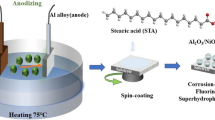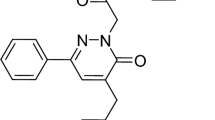Abstract
In this work, the corrosion behavior and mechanism of X70 steel induced by soluble extracellular polymeric substances (s-EPS) extracted from Streptococcus mutans (S. mutans) and sodium molybdate as the mixed corrosion inhibitor in 3.5 wt% NaCl solution were investigated. Results of electrochemical measurements showed that the inhibition efficiency of single s-EPS or sodium molybdate increased with increase in concentration of inhibitor but the inhibition efficiency was not too high, while a synergistic effect existed when s-EPS and sodium molybdate were combined together to prevent X70 steel corrosion. The synergistic effect increased with increasing the concentration of s-EPS from 10 to 40 mg/L in the presence of 50 mg/L sodium molybdate, and the synergistic parameter can achieve 5.46. The mixed inhibitors simultaneously inhibited the anodic and cathodic corrosion of X70 steel clearly, which greatly promoted the activation energy of the corrosion reaction. Results from X-ray photoelectron spectroscopy, atomic force microscopy, and field emission scanning electron microscopy demonstrated that co-adsorption of s-EPS and [(OH)4OMo–O–MoO(OH)4]2− led to the formation of a more homogeneous and protective film on the surface of X70 steel. All the adsorption of single and mixed inhibitors followed the Langmuir adsorption model according to the thermodynamic analysis.
Graphical Abstract













Similar content being viewed by others
Data availability
The authors declare that all the data supporting the findings of this study are available within the article and its supplementary information files.
References
Alentejano CR IV, Aoki, (2004) Localized corrosion inhibition of 304 stainless steel in pure water by oxyanions tungstate and molybdate. Electrochim Acta 49:2779–2785. https://doi.org/10.1016/j.electacta.2004.01.039
Mu G, Li X, Qu Q, Zhou J (2006) Molybdate and tungstate as corrosion inhibitors for cold rolling steel in hydrochloric acid solution. Corros Sci 48:445–459. https://doi.org/10.1016/j.corsci.2005.01.013
Saremi M, Dehghanian C, Sabet MM (2006) The effect of molybdate concentration and hydrodynamic effect on mild steel corrosion inhibition in simulated cooling water. Corros Sci 48:1404–1412. https://doi.org/10.1016/j.corsci.2005.06.009
Qu Q, Li L, Jiang S, Bai W, Ding Z (2009) Effect of sodium molybdate on the corrosion behavior of cold rolled steel in peracetic acid solution. J Appl Electrochem 39:569–576. https://doi.org/10.1007/s10800-008-9694-0
Tang Y, Zhang G, Zuo Y (2012) The inhibition effects of several inhibitors on rebar in acidified concrete pore solution. Constr Build Mater 28:327–332. https://doi.org/10.1016/j.conbuildmat.2011.08.048
Emregül KC, Aksüt AA (2003) The effect of sodium molybdate on the pitting corrosion of aluminum. Corros Sci 45:2415–2433. https://doi.org/10.1016/S0010-938X(03)00097-0
Kwolek P, Kamiński A, Dychtoń K, Drajewicz M, Sieniawski J (2016) The corrosion rate of aluminium in the orthophosphoric acid solutions in the presence of sodium molybdate. Corros Sci 106:208–216. https://doi.org/10.1016/j.corsci.2016.02.005
Shkirskiy V, Keil P, Hintze-Bruening H et al (2015) MoO42− as a soluble inhibitor for Zn in neutral and alkaline solutions. Corros Sci 99:31–41. https://doi.org/10.1016/j.corsci.2015.05.005
Kartsonakis IA, Stanciu SG, Matei AA, Hristu R, Karantonis A, Charitidis CA (2016) A comparative study of corrosion inhibitors on hot-dip galvanized steel. Corros Sci 112:289–307. https://doi.org/10.1016/j.corsci.2016.07.030
Shi J, Wu M, Ming J (2022) In-depth insight into the role of molybdate in corrosion resistance of reinforcing steel in chloride-contaminated mortars. Cem Concr Compos 132:104628
Chen S, Sc Wang Y, Suo G Yang, Du Y, Ren Y (2022) Inhibition effect of tannic acid and sodium molybdate for the flow corrosion of 304 stainless steel on 90° elbow. J Mater Res Technol 20:2408–2420
Zhang W, Li C, Wang W et al (2022) Laminarin and sodium molybdate as efficient sustainable inhibitor for Q235 steel in sodium chloride solution. Coll Surf A Physicochem Eng Asp 637:128199
Ou H-H, Tran QTP, Lin P-H (2018) A synergistic effect between gluconate and molybdate on corrosion inhibition of recirculating cooling water systems. Corros Sci 133:231–239. https://doi.org/10.1016/j.corsci.2018.01.014
Wang B-B, Liu X-T, Chen J-M, Peng D-C, He F (2018) Composition and functional group characterization of extracellular polymeric substances (EPS) in activated sludge: the impacts of polymerization degree of proteinaceous substrates. Water Res 129:133–142. https://doi.org/10.1016/j.watres.2017.11.008
Belando MD, Marín A, Aboal M, García-Fernández AJ, Marín-Guirao L (2017) Combined in situ effects of metals and nutrients on marine biofilms: shifts in the diatom assemblage structure and biological traits. Sci Total Environ 574:381–389. https://doi.org/10.1016/j.scitotenv.2016.08.197
Comte S, Guibaud G, Baudu M (2006) Biosorption properties of extracellular polymeric substances (EPS) resulting from activated sludge according to their type: soluble or bound. Process Biochem 41:815–823. https://doi.org/10.1016/j.procbio.2005.10.014
Moradi M, Song Z, Xiao T (2018) Exopolysaccharide produced by Vibrio neocaledonicus sp. as a green corrosion inhibitor: production and structural characterization. J Mater Sci Technol 34:2447–2457. https://doi.org/10.1016/j.jmst.2018.05.019
Lin Y, Chen J, Zhou X, Li Y (2021) Inhibition of Streptococcus mutans biofilm formation by strategies targeting the metabolism of exopolysaccharides. Crit Rev Microbiol 47:667–677. https://doi.org/10.1080/1040841X.2021.1915959
Liu Y, Li J, Qiu X, Burda C (2007) Bactericidal activity of nitrogen-doped metal oxide nanocatalysts and the influence of bacterial extracellular polymeric substances (EPS). J Photochem Photobiol A 190:94–100. https://doi.org/10.1016/j.jphotochem.2007.03.017
Chen K, Yang X, Qu Q, Wu T, Chen S, Li L (2022) Inhibition of microbiologically influenced corrosion and biofouling of X70 carbon steels by near-superhydrophobic D-cysteine/Ag@ZIF-8 coatings. Corros Sci 208:110682. https://doi.org/10.1016/j.corsci.2022.110682
Alborno A, Islam M, Khraishi R (1989) Multicomponent corrosion-inhibitor system for recirculating cooling water-systems - based on nitrite, molybdate, and inorganic-phosphate. Corrosion 45:970–975. https://doi.org/10.5006/1.3585013
Li S, Li L, Qu Q et al (2019) Extracellular electron transfer of Bacillus cereus biofilm and its effect on the corrosion behaviour of 316L stainless steel. Colloids Surf, B 173:139–147. https://doi.org/10.1016/j.colsurfb.2018.09.059
Zhang W, Cao B, Wang D, Ma T, Xia H, Yu D (2016) Influence of wastewater sludge treatment using combined peroxyacetic acid oxidation and inorganic coagulants re-flocculation on characteristics of extracellular polymeric substances (EPS). Water Res 88:728–739. https://doi.org/10.1016/j.watres.2015.10.049
Hou W, Ma Z, Sun L et al (2013) Extracellular polymeric substances from copper-tolerance Sinorhizobium meliloti immobilize Cu2+. J Hazard Mater 261:614–620. https://doi.org/10.1016/j.jhazmat.2013.06.043
Hosseini M, Mertens SFL, Arshadi MR (2003) Synergism and antagonism in mild steel corrosion inhibition by sodium dodecylbenzenesulphonate and hexamethylenetetramine. Corros Sci 45:1473–1489. https://doi.org/10.1016/S0010-938X(02)00246-9
Wang J, Li Q, Li M-M, Chen T-H, Zhou Y-F, Yue Z-B (2014) Competitive adsorption of heavy metal by extracellular polymeric substances (EPS) extracted from sulfate reducing bacteria. Biores Technol 163:374–376. https://doi.org/10.1016/j.biortech.2014.04.073
Mishra A, Jha B (2009) Isolation and characterization of extracellular polymeric substances from micro-algae Dunaliella salina under salt stress. Biores Technol 100:3382–3386. https://doi.org/10.1016/j.biortech.2009.02.006
Wei D, Li M, Wang X et al (2016) Extracellular polymeric substances for Zn (II) binding during its sorption process onto aerobic granular sludge. J Hazard Mater 301:407–415. https://doi.org/10.1016/j.jhazmat.2015.09.018
Solomon MM, Umoren SA, Quraishi MA, Salman M (2019) Myristic acid based imidazoline derivative as effective corrosion inhibitor for steel in 15% HCl medium. J Colloid Interface Sci 551:47–60. https://doi.org/10.1016/j.jcis.2019.05.004
Franklin MJ, White DC, Isaacs HS (1992) A study of carbon steel corrosion inhibition by phosphate ions and by an organic buffer using a scanning vibrating electrode. Corros Sci 33:251–260. https://doi.org/10.1016/0010-938X(92)90149-W
Sabet Bokati K, Dehghanian C, Yari S (2017) Corrosion inhibition of copper, mild steel and galvanically coupled copper-mild steel in artificial sea water in presence of 1H-benzotriazole, sodium molybdate and sodium phosphate. Corros Sci 126:272–285. https://doi.org/10.1016/j.corsci.2017.07.009
Qiu L-G, Wu Y, Wang Y-M, Jiang X (2008) Synergistic effect between cationic gemini surfactant and chloride ion for the corrosion inhibition of steel in sulphuric acid. Corros Sci 50:576–582. https://doi.org/10.1016/j.corsci.2007.07.010
Rouxhet PG, Genet MJ (2011) XPS analysis of bio-organic systems: XPS analysis of bio-organic systems. Surf Interface Anal 43:1453–1470. https://doi.org/10.1002/sia.3831
Szcześ A, Czemierska M, Jarosz-Wilkołazka A (2016) Calcium carbonate formation on mica supported extracellular polymeric substance produced by Rhodococcus opacus. J Solid State Chem 242:212–221. https://doi.org/10.1016/j.jssc.2016.07.014
Bentiss F, Jama C, Mernari B et al (2009) Corrosion control of mild steel using 3,5-bis(4-methoxyphenyl)-4-amino-1,2,4-triazole in normal hydrochloric acid medium. Corros Sci 51:1628–1635. https://doi.org/10.1016/j.corsci.2009.04.009
Tourabi M, Nohair K, Traisnel M, Jama C, Bentiss F (2013) Electrochemical and XPS studies of the corrosion inhibition of carbon steel in hydrochloric acid pickling solutions by 3,5-bis(2-thienylmethyl)-4-amino-1,2,4-triazole. Corros Sci 75:123–133. https://doi.org/10.1016/j.corsci.2013.05.023
Li S, Qu Q, Li L, Xia K, Li Y, Zhu T (2019) Bacillus cereus s-EPS as a dual bio-functional corrosion and scale inhibitor in artificial seawater. Water Res 166:115094. https://doi.org/10.1016/j.watres.2019.115094
Zarrouk A, Hammouti B, Lakhlifi T, Traisnel M, Vezin H, Bentiss F (2015) New 1 H -pyrrole-2,5-dione derivatives as efficient organic inhibitors of carbon steel corrosion in hydrochloric acid medium: Electrochemical. XPS DFT stud Corros Sci 90:572–584. https://doi.org/10.1016/j.corsci.2014.10.052
Wang Y-q (2018) Inhibitive effect of sodium molybdate on the corrosion behavior of galvanized steel in simulated concrete pore solution. Constr Build Mater 162:383–392. https://doi.org/10.1016/j.conbuildmat.2017.12.035
Satapathy AK, Gunasekaran G, Sahoo SC, Amit K, Rodrigues PV (2009) Corrosion inhibition by Justicia gendarussa plant extract in hydrochloric acid solution. Corros Sci 51:2848–2856. https://doi.org/10.1016/j.corsci.2009.08.016
Liu H-W, Xu D-K, Zheng B-J et al (2018) A synergistic acceleration of corrosion of Q235 carbon steel between magnetization and extracellular polymeric substances. Acta Metallurgica Sinica 31:456–464. https://doi.org/10.1007/s40195-017-0666-4
Acknowledgements
Authors thank Analysis and Measurement Center of Yunnan University for the sample testing service.
Funding
This work was supported by the National Natural Science Foundation of China (grant numbers 52061041, 51661033, 31660538, 51361028, and 51161025), the 13th Graduate Student Scientific 336 Research Innovation Programme of Yunnan University (Grant Number 2021Y384).
Author information
Authors and Affiliations
Contributions
SC contributed to writing—original draft, experiment, investigation, data curation. TW contributed to data management, investigation. FZ contributed to investigation, data curation. KC contributed to investigation, data curation. LL contributed to supervision, resources. QQ contributed to conceptualization, supervision, writing—review and editing.
Corresponding authors
Ethics declarations
Conflict of interest
On behalf of all authors, the corresponding author states that there is no conflict of interest.
Additional information
Handling Editor: Maude Jimenez.
Publisher's Note
Springer Nature remains neutral with regard to jurisdictional claims in published maps and institutional affiliations.
Supplementary Information
Below is the link to the electronic supplementary material.
Rights and permissions
Springer Nature or its licensor (e.g. a society or other partner) holds exclusive rights to this article under a publishing agreement with the author(s) or other rightsholder(s); author self-archiving of the accepted manuscript version of this article is solely governed by the terms of such publishing agreement and applicable law.
About this article
Cite this article
Chen, S., Wu, T., Zeng, F. et al. Streptococcus mutans soluble extracellular polymeric substances and sodium molybdate as mixed corrosion inhibitor for X70 steel. J Mater Sci 58, 2915–2934 (2023). https://doi.org/10.1007/s10853-023-08228-6
Received:
Accepted:
Published:
Issue Date:
DOI: https://doi.org/10.1007/s10853-023-08228-6




